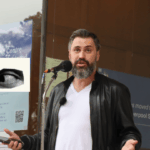No Body, No Release from Prison

Fifteen years ago, the murder of British Backpacker Peter Falconio gripped the world.
The story was almost unbelievable: 8 months into a dream backpacking trip, Mr Falconio and Joanne Lees hired a Kombi to travel through the top end of Australia. On Saturday night, 14 July 2001, about 11kms north of Barrow Creek, a man in a white four-wheel drive waves the Kombi over.
Shot by the road
Peter Falconio gets out of the Kombi. His girlfriend hears a shot. She is then threatened with a small silver hand gun, punched and restrained with cable-tie handcuffs. But she manages to escape, hiding in bushes for several hours before flagging down passing truckies who offer help.
In the wake of the Falconio murder, world media descended on the town of Alice Springs, adding pressure on the small police force trying to solve a murder in a vast outback setting with no body, and one witness.
About 18 months into the case, police admitted having around 2,500 persons of interest, but it was also around this time they got a break in the case.
Bradley John Murdoch, an interstate drug runner, was arrested in South Australia on sexual assault charges. A search of his belongings found cable ties eerily similar to those used to restrain Ms Lees.
Police obtained a DNA sample and were able to link Murdoch to Ms Lees’ t-shirt and the manacles used to restrain her, as well as the gearstick of the couple’s Kombi van.
Murdoch was convicted by a 12-person jury in December 2005. He was sentenced to life imprisonment with a minimum 28-year non-parole period.
No body, no parole
This month marks the 15th Anniversary of Mr Falconio’s murder, and police are revisiting the case, hoping to find his remains.
The decision coincides with proposed new Northern Territory laws which aim to stop convicted murderers like Murdoch from being released on parole until and unless they reveal the location of the victim’s body.
“A person who refuses to show that contrition by giving the family an opportunity at least to bury their loved ones is not a person who is contrite, and is not a person who has even acknowledged frankly that they’ve committed a crime,” said NT Attorney General John Elferink.
“In the case of the Falconio family, they’ve never been able to bury Peter,”
Mr Elferink says he hopes the legislation will encourage Murdoch to reveal the location of Mr Falconio’s remains, and thereby bring some closure to the family.
Injustice to the innocent
A similar law has been in place in South Australia since July last year, and Western Australia is considering introducing similar laws. Other Australian jurisdictions have referred to the laws with approval.
However, many who are experienced in the criminal justice system are wary, saying it would cause further injustice to anyone who had been wrongly convicted; pointing-out that our legal system is littered with people who were convicted of serious crimes on insufficient or dubious evidence.






